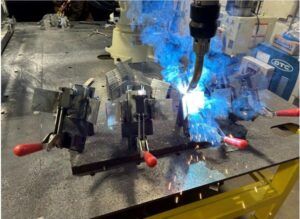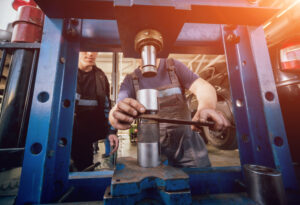Why is Robotic Welding Winning Over Traditional Welding?
In metal fabrication and manufacturing, welding is a necessary procedure. Conventional welding has been the standard for decades, requiring skilled human welders to perform intricate and precise work. However, with the rapid advancement of automation technology, robotic welding has evolved as a game-changer. Today, more industries are adopting robotic welding systems to increase efficiency, productivity, and precision. However, what makes robotic welding superior to traditional welding? In this blog, you will find the answer to why robotic welding is taking the lead.

- Enhanced consistency and precision
One of robotic welding’s biggest benefits is its unparalleled precision. Conventional welding depends on human welders, who, despite their expertise, are still prone to errors due to inconsistencies in methods, environmental factors, or fatigue. In contrast, a robotic welding system is highly accurate, assuring consistent weld quality. Automated welders follow programmed instructions to the letter, eliminating differences and assuring uniformity in each weld.
- Increased productivity and speed
Speed is an essential factor in manufacturing. Conventional welding, though practical, is usually time-consuming and reliant on the welder’s skill and stamina. Robotic welding systems, however, work consistently without breaks, remarkably increasing production speed. A robotic welder can complete tasks in a fraction of the time it would take a human, allowing companies to meet higher demands without sacrificing quality.
- Improved safety for workers
Welding involves hazardous conditions such as high temperatures, ultraviolet radiation, and exposure to gases and fumes. Conventional welders are constantly at risk of burns, eye damage, and respiratory issues. By integrating robotic welding, companies can eliminate the exposure of human workers to these dangers. Robotic systems can handle hazardous tasks in confined or high-risk areas, assuring a safer working environment for employees.
- Reduced labor costs
The shortage of skilled welders is an increasing concern within the industry. Hiring and training experienced welders can be expensive and time-intensive. Robotic welding reduces the dependency on human labor, eliminating operational costs in the long run. When the initial investment in a robotic welding system is significant, the reduction in labor costs and increased efficiency lead to substantial cost savings over time.
- Lower material waste
Inconsistencies in manual or human-led welding can cause defects, resulting in material waste and increased production costs. Robotic welders execute high-precision tasks, reducing errors and eliminating waste material. This efficiency cuts expenses and promotes sustainability by optimizing resource usage.
- Scalability and flexibility
Robotic welding systems are highly adaptable to different manufacturing requirements. They can be reprogrammed for different welding applications, making them suitable for various industries, from aerospace and automotive to construction and shipbuilding. Conversely, conventional welding usually needs specialized skills for other projects, making it less adaptable to changing demands.
- Higher return on investment (ROI)
Although robotic welding needs a remarkable upfront investment, the long-term benefits make it an economically sound decision. Businesses experience increased production efficiency, reduced rework costs, enhanced product quality, and lower labor costs. Over time, these advantages contribute to a strong ROI, making the robotic welding a worthwhile investment for businesses looking to remain competitive.
Robotic welding also aids production with its several types, including arc welding (MIG Welding and TIG welding), plasma welding, resistance welding, and laser welding. Conventional welding lacks variability, slowing down the entire procedure, which is outdated in modern metal manufacturing.
- Integration with Industry 4.0 and smart manufacturing
The growth of Industry 4.0 and smart manufacturing has made automation an integral part of modern production procedures. Robotic welding seamlessly integrates with digital systems, allowing real-time monitoring, predictive maintenance, and data analytics. This connectivity allows manufacturers to optimize their processes, maintain high-quality standards, and reduce downtime.

Robotic welding is revolutionizing the industry by offering precision, safety, cost-effectiveness, and efficiency. While conventional welding still has its proper place for artistic and specialized applications, the advantages of automation make robotic welding the preferred choice for large-scale manufacturing. As technology is consistently evolving, businesses that embrace robotic welding will gain a competitive edge, assuring superior quality and productivity in the long run.
FAQs
- Is robotic welding better than traditional welding?
Robotic welding delivers higher accuracy, consistency, and efficiency than traditional welding. Traditional welding is still applicable for small-scale, creative, and customized applications that require human skill.
- What industries benefit the most from robotic welding?
Industries such as automotive, aerospace, construction, heavy machinery, and shipbuilding benefit the most from robotic welding because they require high-volume, high-quality welding.
- What is the initial cost of robotic welding systems?
The technology’s complexity and application determine the initial robotic welding investment. But in the long run, the benefits of labor, material, and production efficiency make it a good investment.
- Can robotic welding be used for all types of welding jobs?
Despite its great versatility, robotic welding might not be appropriate for specialized, small-scale, or highly complex welding tasks that call for human ingenuity and dexterity.


